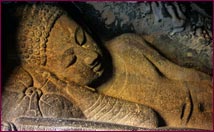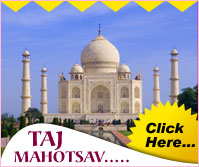Under Aurangzeb, Aurangabad became the seat of the powerful Mughal Empire for a short while. His predecessors prefered Agra, Delhi or Lahore - all in the north, and Aurangzeb's move was not unopposed. But the autocratic Emperor's will prevailed. The Mughal court moved to Aurangabad and remained there till the his death. Built during his years in Aurangabad were such architectural gems as the Bibi-ka-Maqbara, a mausoleum with a marked resemblance to the Taj Mahal and a medieval watermill. Aurangabad became a thriving industrial centre with many fine academic institutions. Its textiles became much sought after and even today, the weavers of Aurangabad produce fine textiles like pathani, himroo and kimkhwab.
But Aurangabad's crowning glory is undoubtedly the famous Buddhist caves at Ajanta & the magnificent rock temples of Ellora. Built between 200 BC and 650 AD, the viharas and chaityas at Ajanta are masterpieces as are the incredibly ornate temples carved out of hard rock at Ellora.
Aurangabad Caves
 Just
outside the city, lie the Aurangabad caves, excavated between the
2nd and 6th century AD. Tantric influences can be discerned in their
architecture and iconography.There are twelve caves in all, a major
chunk of which are viharas, of which Caves 3 and 7, are the most
fascinating. Cave 3 stands supported by 12 finely carved columns,
and sports sculptures portraying scenes from the Jataka tales.
Aurangzeb's TombCave 7 houses an imposing sculpture of a
Boddhisattva, praying for deliverance.
Just
outside the city, lie the Aurangabad caves, excavated between the
2nd and 6th century AD. Tantric influences can be discerned in their
architecture and iconography.There are twelve caves in all, a major
chunk of which are viharas, of which Caves 3 and 7, are the most
fascinating. Cave 3 stands supported by 12 finely carved columns,
and sports sculptures portraying scenes from the Jataka tales.
Aurangzeb's TombCave 7 houses an imposing sculpture of a
Boddhisattva, praying for deliverance.Aurangzeb's Tomb
 You
can visit Aurangzeb's Tomb at Khula-dabad, 25 km distance on the
road to Ellora. Its simplicity has tourist appeal. After Aurangzeb's
death in 1707 it was raised at the expense of late emperor's
self-earned money by copying from Koran. His son Ajam decorated this
tomb without edifice with stone lattice. Malik Ambar and other
historic figures were buried in adjoining Karbala. The Angrakha (a
loose and long robe) used by prophet Mahammad is also carefully
preserved here. There is a Mughal garden nearby- Rani Begam ka Bag.
Another 14 km from Khuladabad lies Mabishmal, a lovely picnic spot.
You can stay at MTDC's Holiday Resort.
You
can visit Aurangzeb's Tomb at Khula-dabad, 25 km distance on the
road to Ellora. Its simplicity has tourist appeal. After Aurangzeb's
death in 1707 it was raised at the expense of late emperor's
self-earned money by copying from Koran. His son Ajam decorated this
tomb without edifice with stone lattice. Malik Ambar and other
historic figures were buried in adjoining Karbala. The Angrakha (a
loose and long robe) used by prophet Mahammad is also carefully
preserved here. There is a Mughal garden nearby- Rani Begam ka Bag.
Another 14 km from Khuladabad lies Mabishmal, a lovely picnic spot.
You can stay at MTDC's Holiday Resort.




